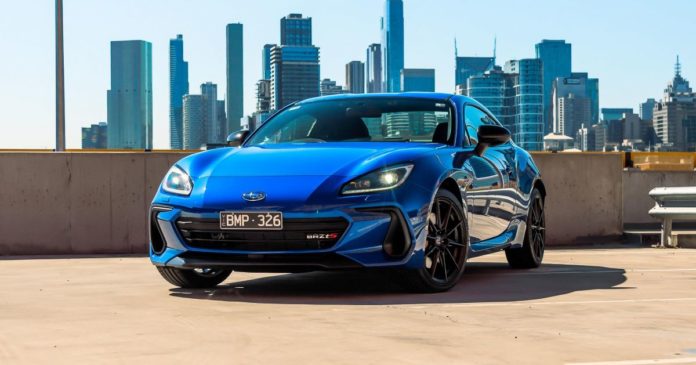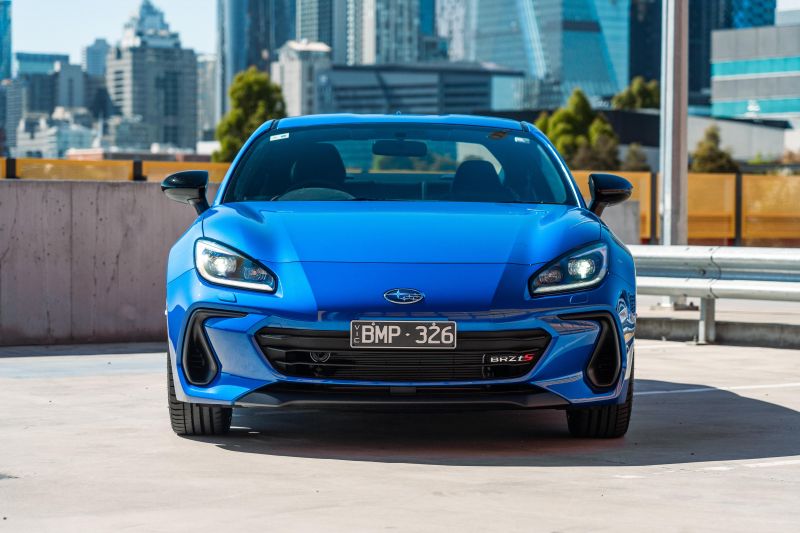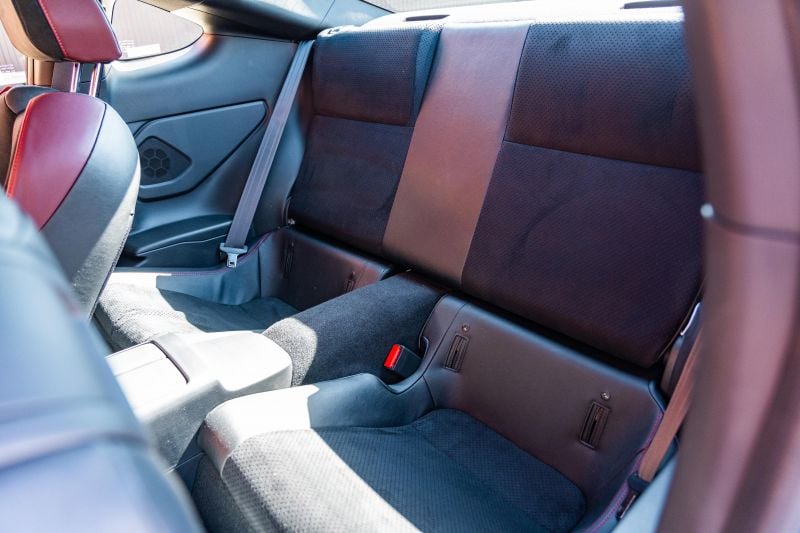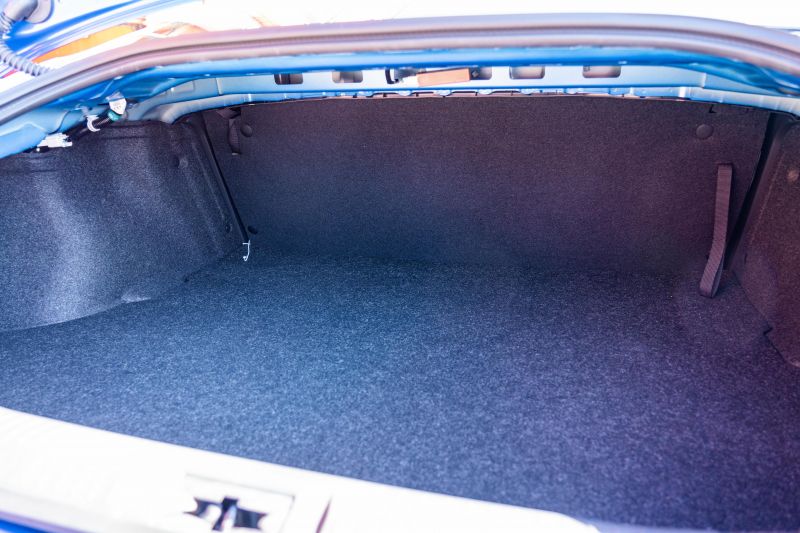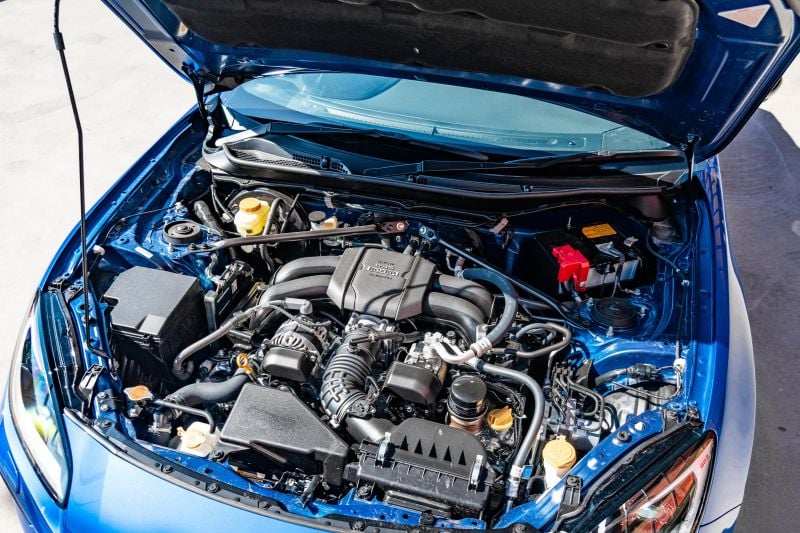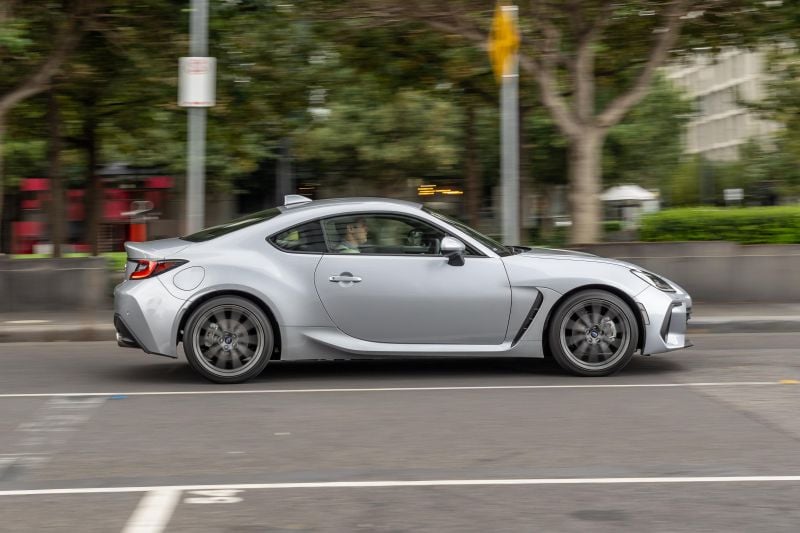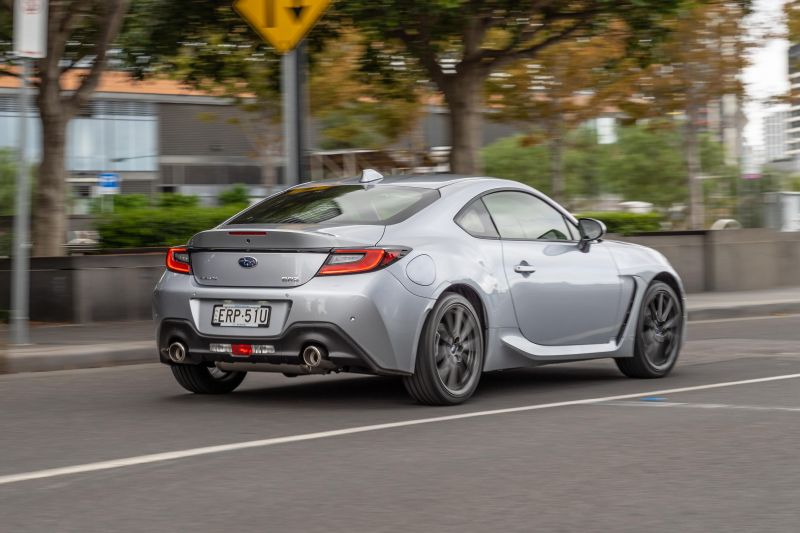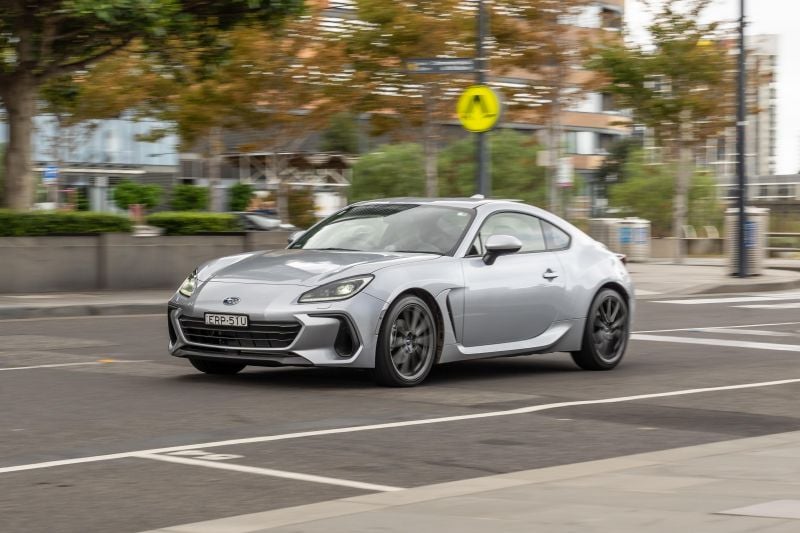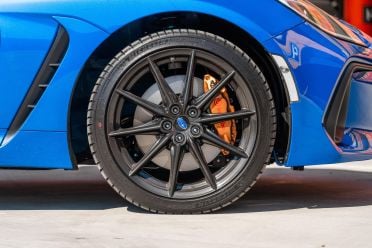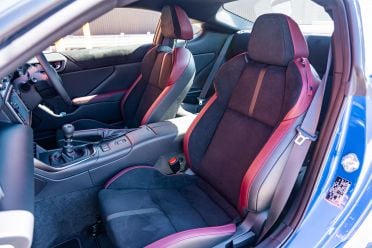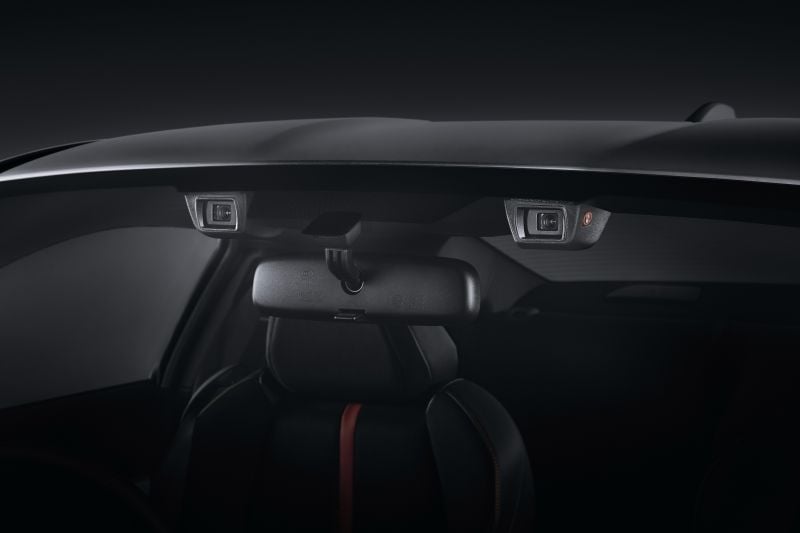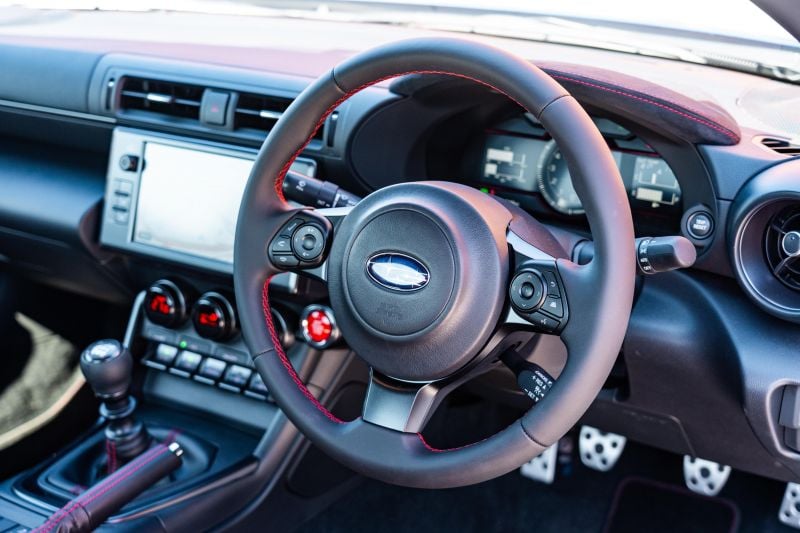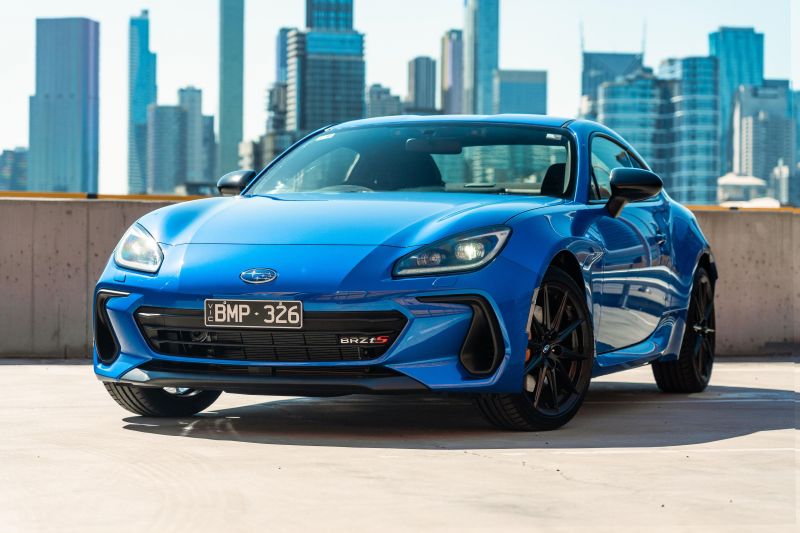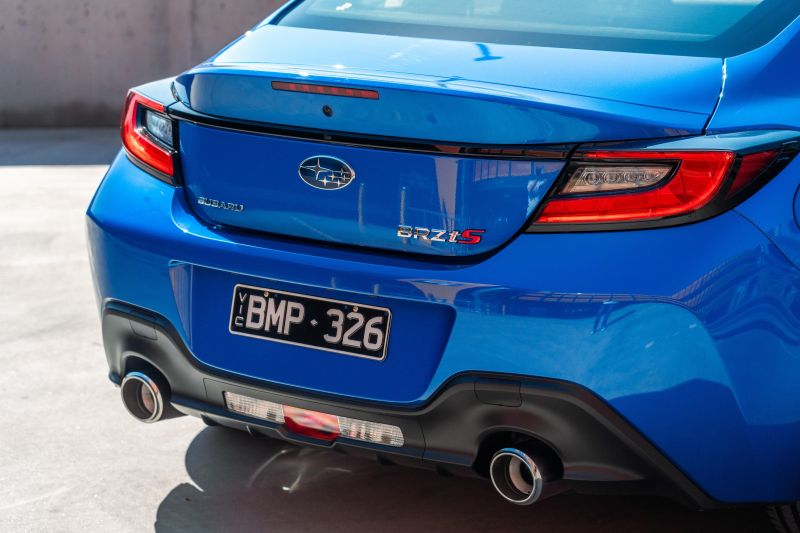With a compact coupe body, rear-wheel drive, and an affordable price tag, the Subaru BRZ is a favourite with buyers keen to modify their cars.
There’s a plethora of aftermarket options for your suspension, brakes, tyres, and engine if you want to turn your little coupe into a giant-slayer on a twisty road or busy track day, and get some grease under your fingernails in the process.
But what if you want a more performance-oriented BRZ without having to bother with workshop visits? That’s where the 2024 Subaru BRZ tS comes in.
Added to the range in 2024, the BRZ tS (tuned by STI) picks up a dampers fettled by STI, along with high-performance Brembo brakes with four-piston front and two-piston rear calipers, and uprated pads and rotors. You also get some exterior tweaks, and a special red-and-black interior.
Of course, you pay for the privilege. The tS will set you back $3600 more than the equivalent BRZ S, and is a whopping $6900 more than the equivalent base model.
Are you better off with a base BRZ and a shopping cart full of modifications, or the range-topping tS?
How does the Subaru BRZ compare?
View a detailed breakdown of the Subaru BRZ against similarly sized vehicles.

Subaru
BRZ
How much does the Subaru BRZ cost?
Prices were hiked across the Subaru BRZ range for 2024, but manual models were hit harder than automatics.
That’s because the former gained EyeSight, a stereo camera behind the windscreen that brings with it active safety features like autonomous emergency braking, adaptive cruise control, and lane-keeping assist.
2024 Subaru BRZ pricing:
- 2024 Subaru BRZ manual: $43,790 (+$3500)
- 2024 Subaru BRZ auto: $44,790 (+$700)
- 2024 Subaru BRZ S manual: $45,090 (+$3500)
- 2024 Subaru BRZ S auto: $46,090 (+$700)
- 2024 Subaru BRZ tS manual: $48,690 (NEW)
- 2024 Subaru BRZ tS auto: $49,690 (NEW)
All prices exclude on-road costs
To see how the BRZ lines up with the competition, check out our comparison tool.
What is the Subaru BRZ like on the inside?
More has changed here in the transition from standard to tS than you might expect.
From the glossy red start button to the burgundy seat highlights, to the subtle burgundy finish on the trim framing the oversized rev counter, there’s a bit here to justify why the tS is a more expensive take on the BRZ.
There’s nothing fundamentally different here, though. The upright dashboard, compact wheel, and generously padded in-house seats are all the same, and it’s a more accomodating place than the first-generation car.
All the bits you touch all the time when you’re driving feel high quality, from the leather-wrapped wheel to the chunky gear knob, and love has gone into designing lower half of the dashboard with its toggles and rotary climate controls… even if it’s all clearly been built to a price.
Could Subaru have gone further? A more focused set of bucket seats wouldn’t go astray if you’re planning to track the car regularly, but a core part of the appeal here is the fact you’re able to daily the car. Racier seats would undermine that.
There’s solid legroom for long-legged drivers thanks to the reshaped dashboard and door pockets, and the centrally-hinged middle armrest is a huge win on long trips.
It can’t be shut if you have a drink bottle in the cupholders (or your phone is sitting wrong), but there’s a slot in the door pockets to help solve that problem.
Facing the driver is a digital dashboard, which was Subaru’s first in Australia. The Solterra, also a vehicle co-developed with Toyota, was the second for those playing at home.
It’s simple but effective, with speed and revs prominently in the centre flanked by the temperatures on the right-hand side, and a customisable trip computer on the left. Data nerds will enjoy the live power and torque traces, and it’s rare in 2024 to be able to easily access your oil temperature rather than just the water temperature.
Infotainment isn’t standout, but it’s solid.
The 8.0-inch display is running a cut-down version of the software in the Impreza and Outback, with wired Apple CarPlay and Android Auto and no-frills graphics.
It’s easy to jump around on the move, and the camera is much improved over the janky unit offered on the last BRZ.
If you’re keen to carry four people regularly, this isn’t the car for you. The rear seats are fine for bags, but they’re only really designed to carry humans in an emergency with negligible headroom and legroom.
The good news is they still fold flat, which makes the BRZ far more practical than you might expect. Having owned a previous-generation BRZ, I can tell you the back seats (and the ability to fold them) really does come in handy if you want to live with the car.
Boot space is a usable 201 litres, and the loss of the spare wheel makes it a more usable space than before. Of course, that also means if you do get a flat tyre you’re stuck wrangling a carton of goo instead of a proper spare.
What’s under the bonnet?
The BRZ tS might be more performance-oriented than the base model and the S, but it doesn’t pick up any more power. It still features the same 2.4-litre naturally aspirated ‘Boxer’ petrol engine.
| Model | Subaru BRZ tS |
|---|---|
| Engine | 2.4L 4cyl boxer |
| Power | 174kW (7000rpm) |
| Torque | 250Nm (3700rpm) |
| Transmission | 6-speed manual |
| Driven wheels | Rear-wheel drive |
| Weight | 1235kg (tare) |
| Fuel economy (claim) | 9.5L/100km |
| Fuel economy (observed) | 10.5L/100km (mixed driving) |
| Fuel tank size | 50 litres |
| Fuel requirement | 98 RON |
You can choose between a manual or automatic transmission, but the automatic has never been the pick in the BRZ and Toyota 86.
How does the Subaru BRZ drive?
As is the case with the interior, there are some changes to the garnish of how the BRZ tS drives and handles, but it’s fundamentally the same car – that’s for the best.
-
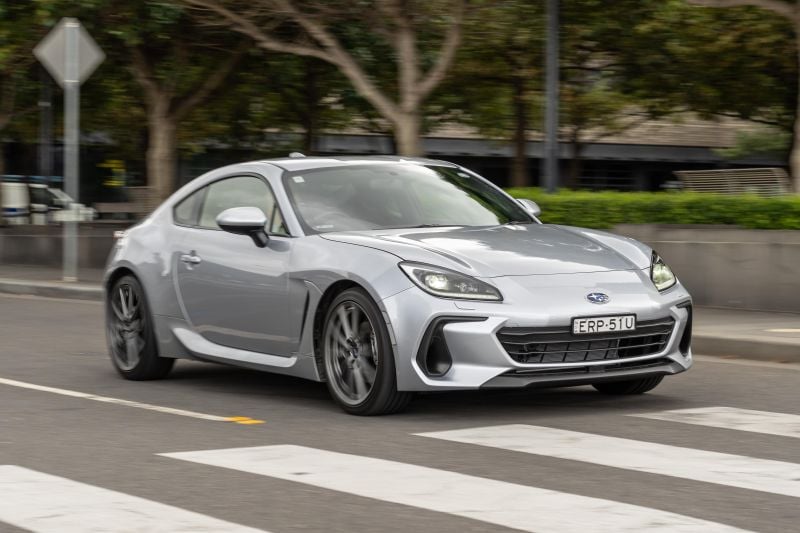
BRZ shown
Slot the stubby shifter into first and the light, short action instantly feels familiar, as does the slightly springy clutch. The second you ease off the clutch, however, the bigger new engine has torque in all the places the first-generation car was missing it.
It pulls more happily from the bottom of second or third gear around town, and when the road opens up that horrid torque valley in the mid-range of the last car has been flattened out. It’s not going to crush your chest and make you beg for mercy with its sheer pace, but getting the best out of it doesn’t feel like a chore anymore.
The 2.4-litre engine has the same slightly offbeat bark as before, piped into the cabin for a bit more drama behind the wheel, but it’s not coarse or buzzy like before at the top end.
There’s no doubt the manual transmission is the pick. The pedals are well spaced for rev-matching – a necessity given there’s no technology to help you out – and having to row your own is perfectly in keeping with the car’s pitch as an analogue beast in an increasingly digital world.
It’s also still right at home in the more performance-focused tS; even the sharper automatic in the second-generation BRZ is lazier than the dual-clutch tech available elsewhere in the performance world, where the manual puts your fate into your own hands.
Subaru and Toyota say the synchros on the manual have been tweaked to make the second-to-third shift quicker and smoother, and the shift from neutral to first a bit less crunchy, but the transmission feels fundamentally the same as before.
Ride quality has always been a BRZ strong suit, and the revised dampers in the tS don’t turn it into a rough-and-ready track special. It still soaks up potholes and sharp expansion joins well enough to be comfortable on the daily grind, and breathes with crests and dips in the road rather than aggressively trying to drag its weight back into line.
Is it tauter than the standard car? To my arse the answer is yes, but it’s not a fundamentally different car. I’ve driven modified examples set up for track work that were significantly harsher, so Subaru hasn’t gone as far as maybe it could have.
The brakes are also at the core of what’s changed here, but in day-to-day driving you don’t really notice the extra stopping power.
On a blast in the hills they didn’t immediately stand out as wildly different, but one of the first things owners who want to track their cars regularly will change are the stock pads, rotors, and fluid, as they don’t hold up all that well to sustained abuse on the track as well as they could.
If you are serious about putting some track miles under your wheels, they’d more likely come into their own.
Subaru didn’t need to fiddle with the car’s steering, which was just right from the start. Thankfully, they haven’t.
There’s no artificial heaviness or faux-sporty quickness built in, but the still goes exactly where you want it to, and there’s enough feedback through the wheel and seats to feel what the car is doing beneath you.
It’s beautifully balanced, and even fitted with stickier Michelin Pilot Sport 4S rubber in place of the low rolling resistance Primacy tyres offered on some trim grades it’s possible to transition from grip to slip without too much trouble.
Even if you’re not trying to pull off big, lairy slides it feels overtly rear-wheel drive under power, allowing you to play with the rear on corner exit, while a little liftoff the throttle has the nose tucking in.
There are no turbochargers to get in the way so throttle response is excellent, and the lack of power (at least, by 2024 standards) means you can really enjoy its performance on the road without constantly worrying about making a donation to the boys (and girls) in blue.
As for the active safety equipment? It works well, and it does make the manual feel much more modern.
The adaptive cruise is smooth, the lane departure warning isn’t constantly kicking in or jumping at shadows, and the blind-spot monitor makes it easier to drive a car with a significant blind-spot in traffic.
They make this an easier car to drive long distances, although the fact the engine is buzzy at 100km/h in sixth gear and there’s plenty of road noise on average Australian country highways does undermine its claims as a GT.
What do you get?
Subaru doesn’t leave even base model buyers short on equipment.
The BRZ comes with:
- 18-inch alloy wheels
- 18-inch spare
- 215/40 R18 85Y tyres
- Tyre pressure monitoring
- Automatic LED headlights
- Active bending (steering responsive)
- Self-levelling
- Automatic high-beam
- Heated, power-folding exterior mirrors
- Dual-zone climate control
- 7.0-inch instrument cluster screen
- 8.0-inch touchscreen infotainment system
- Satellite navigation
- DAB+ digital radio
- Apple CarPlay and Android Auto
- 6-speaker sound system
- Keyless entry and start
- Leather-wrapped steering wheel and shifter
- Cloth upholstery
- 1 x 12V outlet
- 2 x USB-A outlets
The BRZ S adds:
- Ultrasuede and leather-accented upholstery
- Heated front seats
The BRZ tS adds:
- Brembo 4-piston front, 2-piston rear brakes
- Grey 18-inch alloy wheels
- Bordeaux interior highlights
- STI-tuned suspension
The tS loses its spare wheel for a tyre repair kit.
Is the Subaru BRZ safe?
The Subaru BRZ has yet to be tested by Euro NCAP or ANCAP.
Adaptive cruise control, autonomous emergency braking, lane departure warning, lane-keep assist, and high-beam assist are both new to the manual, which has picked up Subaru’s stereo EyeSight camera behind the windscreen for 2024.
All BRZ models come standard with the following equipment:
- Adaptive cruise control
- Autonomous emergency braking (AEB)
- Blind-spot monitoring
- Lane departure warning
- Lead vehicle departure alert
- Rear cross-traffic alert
- Reversing camera
- Front, front-side, curtain and driver’s knee airbags
Automatic models gain:
- Reverse AEB
- Rear parking sensors
How much does the Subaru BRZ cost to run?
The Subaru BRZ is backed by a five-year, unlimited-kilometre warranty.
Subaru offers five years of capped-price servicing. These services are capped at $364.03, $586.06, $459.43, $739.82 and $379.14, respectively, except in auto models where the fourth service rings up at $824.07.
Servicing is required every 12 months or 15,000km, whichever comes first.
CarExpert’s Take on the Subaru BRZ
The tS is a well executed upgrade of the BRZ, but it doesn’t revolutionise the formula.
The new dampers offer a hint more control, the new brakes show promise if you’re spending life at the racetrack, and the cosmetic changes are nicely executed.
The addition of a full active safety suite finally brings the manual into line with the automatic… and the broader new car market in 2024, which is overdue but welcome.
With more torque and an evolved chassis the latest BRZ remains brilliant to drive on the road, and leaves you room to grow on the track.
The tS is the nicest BRZ you can buy, but it’s not the one I would buy.
Its upgrades are well targeted, but don’t bring enough for the average punter to justify spending more – and if you are keen to build your car into a track monster, the aftermarket lets you go further.
Click the images for the full gallery
MORE: Buy a Subaru BRZ
MORE: Everything Subaru BRZ

